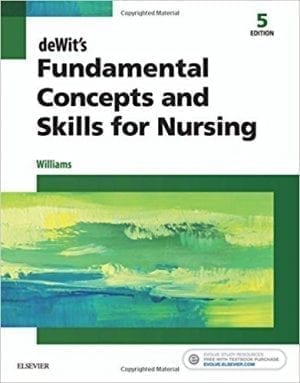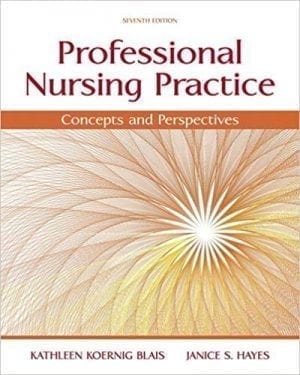Skills in Clinical Nursing 8th Edition by Audrey J. Berman – Test Bank
Chapter 5
Exam Name___________________________________
MULTIPLE CHOICE. Choose the one alternative that best completes the statement or answers the question.
1) The recommended technique for the nurse to use when brushing the client’s teeth is the: 1)
A) Sulcular technique. B) Xerostomia technique. C) Gingivitis technique. D) Pyorrhea technique.
Answer: A Explanation:
A) The sulcular technique aims the toothbrush at an angle toward the gums, and is recommended as the best means of brushing the client’s teeth. Xerostomia is the term for dry mouth, and there is no technique associated with it. Gingivitis is a form of periodontal disease causing red swollen gingiva. Pyorrhea is loose teeth and pus that is evident when the gums are pressed.
Cognitive Level: Knowledge
Client Need: Physiological Integrity Nursing Process: Implementation
B) The sulcular technique aims the toothbrush at an angle toward the gums, and is recommended as the best means of brushing the client’s teeth. Xerostomia is the term for dry mouth, and there is no technique associated with it. Gingivitis is a form of periodontal disease causing red swollen gingiva. Pyorrhea is loose teeth and pus that is evident when the gums are pressed.
Cognitive Level: Knowledge
Client Need: Physiological Integrity Nursing Process: Implementation
C) The sulcular technique aims the toothbrush at an angle toward the gums, and is recommended as the best means of brushing the client’s teeth. Xerostomia is the term for dry mouth, and there is no technique associated with it. Gingivitis is a form of periodontal disease causing red swollen gingiva. Pyorrhea is loose teeth and pus that is evident when the gums are pressed.
Cognitive Level: Knowledge
Client Need: Physiological Integrity Nursing Process: Implementation
D) The sulcular technique aims the toothbrush at an angle toward the gums, and is recommended as the best means of brushing the client’s teeth. Xerostomia is the term for dry mouth, and there is no technique associated with it. Gingivitis is a form of periodontal disease causing red swollen gingiva. Pyorrhea is loose teeth and pus that is evident when the gums are pressed.
Cognitive Level: Knowledge
Client Need: Physiological Integrity Nursing Process: Implementation
Objective: Learning Outcome 5-1: Define the key terms used in the skills of hygienic care.
1
2) The nurse is caring for a client who had abnormal hair growth as a side effect of medical treatment. 2) The nurse documents this as:
A) Alopecia.
Answer: B Explanation:
B) Hirsutism. C) Pediculosis. D) Scabies.
A) Hirsutism is abnormal hair growth. Alopecia is hair loss. Pediculosis is commonly known as lice. Scabies is a contagious skin infection caused by mites.
Cognitive Level: Knowledge
Client Need: Physiological Integrity
Nursing Process: Assessment
B) Hirsutism is abnormal hair growth. Alopecia is hair loss. Pediculosis is commonly
known as lice. Scabies is a contagious skin infection caused by mites. Cognitive Level: Knowledge
Client Need: Physiological Integrity
Nursing Process: Assessment
C) Hirsutism is abnormal hair growth. Alopecia is hair loss. Pediculosis is commonly known as lice. Scabies is a contagious skin infection caused by mites.
Cognitive Level: Knowledge
Client Need: Physiological Integrity
Nursing Process: Assessment
D) Hirsutism is abnormal hair growth. Alopecia is hair loss. Pediculosis is commonly
known as lice. Scabies is a contagious skin infection caused by mites. Cognitive Level: Knowledge
Client Need: Physiological Integrity
Nursing Process: Assessment
Objective: Learning Outcome 5-1: Define the key terms used in the skills of hygienic care.
2
3) The nurse is planning the day, and will perform morning care: 3)
A) When the client first awakens. B) After breakfast.
C) Before retiring for the night. D) Whenever the client requests it.
Answer: B Explanation:
A) The nurse generally provides morning care after breakfast. Early-morning care is provided when the client first awakens. Hour of sleep (HS) care is provided before going to bed. PRN care is provided as required by the client.
Cognitive Level: Knowledge
Client Need: Physiological Integrity
Nursing Process: Planning
B) The nurse generally provides morning care after breakfast. Early-morning care is
provided when the client first awakens. Hour of sleep (HS) care is provided before going to bed. PRN care is provided as required by the client.
Cognitive Level: Knowledge
Client Need: Physiological Integrity
Nursing Process: Planning
C) The nurse generally provides morning care after breakfast. Early-morning care is
provided when the client first awakens. Hour of sleep (HS) care is provided before going to bed. PRN care is provided as required by the client.
Cognitive Level: Knowledge
Client Need: Physiological Integrity
Nursing Process: Planning
D) The nurse generally provides morning care after breakfast. Early-morning care is
provided when the client first awakens. Hour of sleep (HS) care is provided before going to bed. PRN care is provided as required by the client.
Cognitive Level: Knowledge
Client Need: Physiological Integrity
Nursing Process: Planning
Objective: Learning Outcome 5-2: Describe the kinds of hygienic care nurses provide to clients.














Reviews
There are no reviews yet.